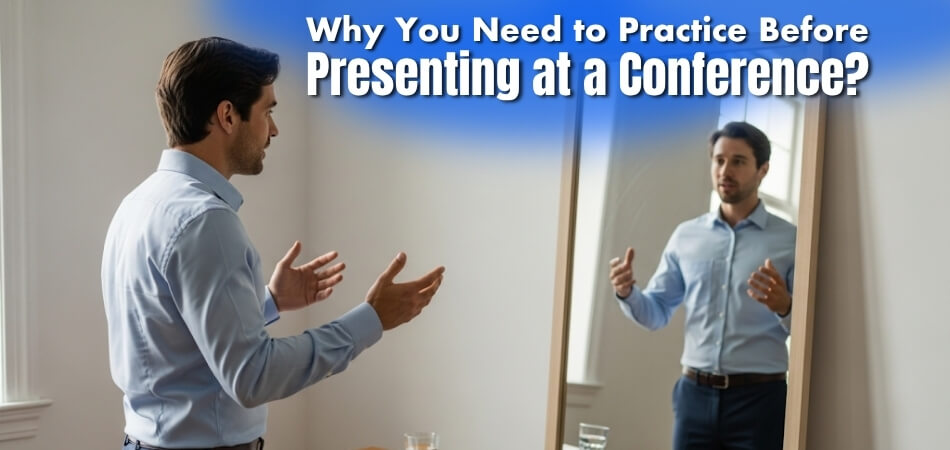Presenting at a conference can be both exciting and a little scary. You stand in front of a crowd, sharing ideas you’ve worked hard on. Everyone is listening, and you want everything to go just right. That’s when many people start thinking about why you need to practice before presenting at a conference.
Practice before a conference builds confidence, clarity, and control. It helps improve your voice, smooth transitions, and spot mistakes. You also test your tech and prepare for questions. Practicing shows you care and helps your message stay clear and strong.
If you’re interested in giving a strong presentation that people enjoy and remember, this article is for you. You’ll find everything you need to know—from common mistakes to how much to practice. Each part gives simple tips to help you feel ready and do your best.
Why You Need to Practice Before Presenting at a Conference?
When you’re preparing to speak at a big event, it’s not just about putting words on slides. There’s a lot more to it if you want your talk to be smooth and memorable. Here’s why practicing before a presentation is super important.

Builds Real Confidence
The more you go over your presentation ahead of time, the more confident you’ll feel. Rehearsing helps you get used to your material, so you’re not worried about forgetting what to say. With enough practice, your nerves settle down and you start to feel ready. If you’re preparing for global events like upcoming conferences in USA, Canada, or any other country, this kind of confidence can really make a difference when facing a large audience.
Makes Things Clear
You might think your points make sense, but once you say them out loud, you may spot things that are confusing or repeated. Practice lets you clean up your talk so it’s easier to understand. You also learn how long each part takes, so you stay on track and don’t run over your time. That way, your talk feels organized, smooth, and clear from start to finish.
Helps Your Voice
Every time you go through your presentation, you learn how to speak better. You can work on how loud you are, when to pause, and how to put energy into your words. This makes your talk more fun to listen to. It also helps cut down on awkward sounds like “umm” and “uhh.” People will understand you better and stay more interested in what you’re saying.
Smooth Moves
With enough practice, your slides and ideas flow together nicely. You won’t have to keep checking notes or struggling with what comes next. Instead, everything fits like a story. This makes your presentation easier to follow, and it helps people stay focused. It also shows that you’re fully prepared and in control, which makes you look professional and sharp.
Tests the Tech
Before the real event, it’s smart to try out all the tools you’ll be using. This means checking your laptop, remote clicker, microphone, or any videos. If something goes wrong during practice, you can fix it ahead of time. That way, you’re not stuck dealing with tech problems in front of everyone. Practicing with the equipment makes your talk smoother and less stressful.
Prepares for Questions
Running through your talk a few times helps you think of questions the audience might ask. You don’t need to memorize answers, but having an idea of what might come up helps you feel ready. This way, when someone asks a tough question, you can stay calm and reply clearly. It also shows that you really know your topic well.
Shows You Care
When you take time to practice, it shows you’re serious about your talk. It means you care about giving people something useful and not wasting their time. A clear and smooth presentation is easier to enjoy, and it leaves a better memory in people’s minds. Practice is how you make your ideas stand out and be remembered.
Practicing before a presentation isn’t just helpful—it’s necessary. It gives you the confidence to speak clearly and keeps your talk on track. You’ll avoid surprises and handle any hiccups with ease. Most importantly, it helps your message stick with the audience.
How to Practice Your Conference Presentation Effectively?
Getting ready for a conference presentation can feel a little scary at first. You might wonder how to say things clearly or how not to forget your lines. But don’t worry—there are smart ways to practice that can really help. Let’s look at some simple and fun ways to make your presentation better and more confident.
Talk to the Mirror
One great way to practice is by speaking in front of a mirror. When you do this, you can see how your face looks when you talk and check your body movements too. Try to smile and use your hands naturally. Watch how your eyes move—try not to look away too much. This helps you become more comfortable with your own style. Keep doing it until you feel sure and calm.
Time Yourself
Timing is super important in any presentation. Use a clock or stopwatch to see how long you take. Practice your full talk without stopping and note the time. If it’s too long, cut some parts. If it’s too short, add more points. Doing this will help you speak at a steady pace and not rush. Keep practicing until you stay within your time limit easily.
Record and Watch
Recording yourself on a phone or camera is a very smart idea. When you watch the video later, you can notice things you didn’t feel while speaking. Maybe you’re speaking too fast or saying “uh” a lot. Maybe your voice sounds too low. Watching your own video helps you fix these small things one by one. It may feel weird at first, but it really works.
Use Fake Audiences
Ask your family or friends to be your pretend audience. Stand in front of them and give your talk just like you would in the real event. It may make you a little nervous, but that’s a good thing! It helps you practice in front of real people. After you’re done, ask them how you did and what you can improve. Their feedback will help you a lot.
Repeat, Repeat, Repeat
The more times you practice, the better you’ll get. Repeat your whole presentation many times until you know it very well. This doesn’t mean you need to memorize every word, but it helps you remember your key points. Repeating also helps you feel more relaxed when you speak. Practice in different places and at different times to feel even more confident.
A well-practiced presentation often starts with knowing your research paper inside out. This includes reviewing how you write an introduction for a conference paper, as it often shapes the opening remarks of your talk.
How Much Should You Rehearse Before Your Conference Presentation?
Standing in front of a crowd and giving a talk can feel exciting but also a little nerve-wracking. One big question many people ask is, “How much should I rehearse?” The answer isn’t always simple, but a little planning goes a long way. Keep reading to learn easy tips that can help you feel confident and ready for your big moment!
- Know Your Time Limit: Short talks need more careful practice so you can say everything clearly without running out of time or rushing too fast.
- Practice the Full Talk: Going through your entire talk several times helps you feel more natural and spot any parts that don’t sound smooth.
- Focus on Tricky Parts: If there’s a section where you always mess up or forget what to say, keep practicing it until it becomes easy.
- Polish the Start and End: A strong beginning grabs attention, and a good ending leaves people remembering your message long after your talk is over.
- Use Your Slides While Practicing: Practice with your slides so you know exactly what to say for each one and when to move to the next.
- Record and Watch Yourself: Watching your practice video helps you fix things like saying “um” too much or not looking at your audience.
- Rehearse in the Real Setup: If you’ll be standing, use a clicker, or speaking online, try practicing in that same way to feel more prepared.
- Spread Out Practice Sessions: Don’t wait until the last day. Practice a little every day so your brain has time to remember and relax.
- Ask Someone to Listen: A friend or family member can give helpful feedback on parts that are unclear, too fast, or maybe even a bit boring.
- Get Ready for Questions: Think about what people might ask you after your talk and have a few good answers ready in your mind.
The more you practice, the more your talk will feel like a normal conversation instead of a stressful performance. You don’t need to be perfect—just clear, calm, and prepared. Rehearsing the right way helps you sound confident and keep your audience interested. With these tips, you’ll be ready to give a great presentation!
Should You Practice With Slides or Without Them for Presenting at a Conference?
When getting ready for a presentation, many people wonder if they should use their slides while practicing or not. Both ways can help, depending on what you’re trying to improve. Each method has its own good points. Let’s break it down and see what really works best for you.
Practicing With Slides
Using your slides while practicing helps you match your words with your pictures or points. You can see when to click and what to say with each slide. This makes the whole talk flow better. It also helps you avoid saying too much or too little. Slides give you clues about what comes next, which can be super helpful when speaking.
Going Without Slides
Sometimes, it’s good to practice without looking at the slides. This helps you focus on your main ideas without getting distracted by the screen. It also trains your brain to remember the talk in a natural way. If something goes wrong with the slides during the real presentation, you’ll still know what to say. It builds more speaking confidence.
Mixing Both Styles
You don’t have to choose only one way. Try practicing with slides some days and without them on other days. This mix helps you get used to both styles. You’ll learn how to depend on the slides when needed, but not too much. It also keeps your practice fresh and less boring. It’s like training your mind in two helpful ways.
Know Your Slide Order
Even if you don’t look at the slides while speaking, it’s very important to know the order of the slides. This helps you know what comes next without needing to check the screen all the time. If you know what slide is coming, you’ll look smoother and ready. It also keeps your speaking clear and steady without long pauses.
Practice Like It’s Real
The best practice is when it feels like the real thing. Stand up, open your slides, and speak out loud like you’re in front of a real crowd. Use your clicker or keyboard to move slides like you would on the day. This helps you feel how the real moment will be. It makes you more ready and less nervous.
Both ways of practicing—using slides or not—can help you in different ways. Try them out and see what feels better for you. What matters most is feeling ready and confident. Keep practicing, and you’ll do great!
Common Mistakes to Avoid When Practicing for a Conference Presentation
Getting ready for a conference talk takes more than just writing slides. Even small mistakes during practice can cause big problems during the real talk. Many people forget important things when they don’t rehearse properly. Read below to find out what to avoid while practicing.
Rushing Through
Most people try to say too much in too little time. This makes the audience feel lost and hard to follow your message. You might skip ideas or speak too fast without realizing it. When you practice slowly, your talk becomes easier to understand. It also gives you time to breathe and stay calm. A steady pace keeps your ideas clear and your voice strong. Take your time so others can enjoy your talk.
Ignoring Time Limits
A lot of speakers don’t check how long their talk actually takes. This often leads to going overtime or skipping slides at the end. You should always rehearse with a timer before the real presentation begins. It helps you plan what to say and what to leave out. Respecting the time shows you’re well-prepared and professional. Staying within limits also gives others enough time to speak too.
Sounding Flat
Some talks sound boring because the speaker talks in the same tone. This flat voice can make even good content seem dull and dry. If you add energy and expression, people will listen more closely. Practice helps you hear your own tone and make changes. Try smiling or raising your voice slightly at key points. These small tricks make your words feel more alive and interesting.
Missing Key Points
You may forget your main ideas if you don’t practice enough. This leaves your audience confused about what your talk was really about. Repeating your presentation helps lock those key points in your mind. Notes or slide reminders can also help you stay on track. Practice also helps you avoid losing your place in the middle. The more prepared you are, the easier it is to remember everything.
Overlooking Details
Tiny things like your slides or visuals can make a big impact. While rehearsing, don’t overlook small but important details like whether your visuals match the tone and clarity of your materials. Even the conference paper font you use can subtly affect how professional and readable your handouts or projected content appear. Little mistakes in these areas can distract from your message. Careful planning of small things helps your talk look clean and neat.
Practicing your talk the right way helps you avoid big mistakes. It also makes you feel calm and ready for the real day. A smooth, clear talk is always better than a rushed one. Take time to prepare well, and you’ll do great.
Frequently Asked Questions
You might still have a few questions in mind about why practice is such a big deal before giving a conference presentation. That’s totally normal! A little extra info can help you feel even more ready. Below are some helpful questions and answers to clear up any doubts you may have.
What If I Feel Shy Talking Out Loud?
It’s okay to feel shy at first. Practicing by yourself can help you feel more comfortable speaking out loud. You can start in a quiet room and slowly try talking in front of others. The more you do it, the less nervous you’ll feel over time.
Can Practicing Help Me Remember My Talk?
Yes, it really helps! When you go over your presentation again and again, the ideas stick better in your mind. You don’t need to memorize every word, just remember the key points. Practice makes you feel more ready and less forgetful.
Does Practicing Make My Voice Sound Better?
Yes, it does. You learn how to speak more clearly and with better volume. It also helps you stop saying “uhh” and “umm” too often. A strong voice makes people listen and enjoy your talk more.
Should I Practice Even If I Know My Topic Well?
Even if you know your topic, you still need to practice. Speaking out loud is different from just knowing the facts in your head. Practice helps you explain things in a way that makes sense to others. It also helps you spot any parts that sound confusing.
Can Practicing Help Me Stay Calm?
Yes, it can. When you know what to say and how to say it, you feel more relaxed. Practice helps take away the fear of forgetting something or messing up. You’ll feel more in control and less worried.
How Does Practice Help My Body Language?
Practicing helps you notice how you stand, move your hands, and make eye contact. These things matter a lot when you’re on stage. You’ll look more confident if your body language is calm and friendly. Practice helps you use natural movements instead of awkward ones.
Can Practicing Help Me Speak Slower?
Yes! Many people talk too fast when they’re nervous. Practicing helps you slow down and pause at the right times. It also helps the audience understand you better. A slower pace makes your message clearer.
Is It Okay to Practice in Small Parts?
Absolutely! You can practice one section at a time if the full talk feels too long. Then put all the parts together later. This makes it easier to remember and improves each section. It also helps you feel more organized.
What If I Keep Making Mistakes?
Mistakes are part of learning. The more you practice, the fewer mistakes you’ll make. And even if you mess up, you’ll know how to fix it quickly. Practice helps you stay calm when small things go wrong.
Bottom Line
Taking time to practice before a presentation is one of the smartest things you can do. It helps you feel relaxed, stay on time, and speak with a clear voice. You learn how to fix little problems before the real day. Your message becomes easier to follow and more fun to listen to. That’s exactly why you need to practice before presenting at a conference—because it turns nervous energy into real confidence and makes your talk much better.
Before you step on stage, remember a few quick tips: speak clearly, stay calm, check your time, and don’t rush your words. Try to smile, use your hands naturally, and make eye contact when you can. Small changes like these can make a big difference. Now go ahead, give it your best, and good luck with your presentation—you’ve got this!







